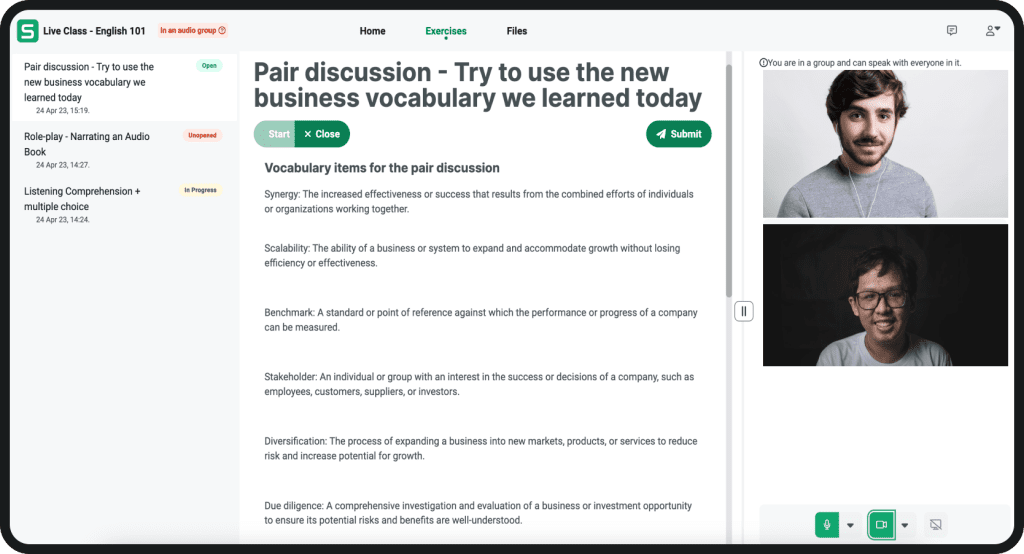Although there are a wide variety of different approaches to language teaching and an infinite variety of pupils, classroom environments and educators, most learning tends to take place in a unit of time known as a lesson. Whilst the content of each lesson is usually determined by the teacher, lesson structures can provide a useful template to give learners a wide variety of different content and contexts.
Of course, there’s no set formula for how educators should structure a lesson, but in his book Learning Teaching, Jim Scrivener outlines a model to describe three key stages of any language class. This model is called ARC and is widely used by language educators globally. This blog post explores the ARC lesson in detail and explains how it can be most successfully deployed in language teaching.
What is the ARC lesson structure?
The ARC approach is a way to describe three potential and sequential stages in any lesson. Scrivener names them: ‘Authentic use,’ ‘Restricted use’ and ‘Clarification and focus.’ His stated intention was that educators should consider the three stages as a sort of checklist to have in their mind when lesson planning.
For Scrivener, students should have the opportunity to participate in all three aspects in every lesson, whilst educators should feel free to use the elements in whatever balance / order is most appropriate for the lesson objectives. For example, a conversation-based lesson would normally have more authentic use activities, while a grammar-focused lesson would naturally involve more clarification and focus.
Authentic use activities
These language learning activities or tasks should provide students with the chance to use the target language in the most natural and realistic way in the classroom. Tasks of this type should mirror activities that native speakers of the target language might do in their everyday lives. Authentic tasks will therefore place a genuine communicative demand on students.
This demand could be either receptive or productive. A receptive task might involve listening to or reading an authentic piece of text, whilst a productive task could be a free or open speaking activity on a particular theme or topic. In both cases, the student needs to have a clear understanding of the language to fluently complete them.
In the language classroom, example of these tasks might include:
- Role plays with peers or native speakers
- Interview tasks
- Listening to or reading news reports
- Phoning for information (e.g train times, hotel availability etc.)
- Planning a trip or a party
- Completing a form or residency application
These exercises help to highlight to students how the communication / language skills they are learning can be used in the real-world. As such, they provide powerful motivation and encourage their continued engagement and participation.
Restricted use activities
As the name suggests, these activities require students to demonstrate their knowledge of a specific learning objective in a tightly-targeted manner. It is therefore very similar in form to the Practice Stage of the PPP teaching approach in that it requires students to produce the language point in a very accurate and controlled manner.
Examples of restricted use activities might include:
- Worksheets
- Gap fill exercises
- Substitution exercises (where the student uses the form / phrase in a different way).
- Grammar and vocabulary drills
Restricted use activities play a key role in the language learning process. They support students to specifically practice their newly-acquired knowledge (e.g grammar or vocabulary) through dedicated exercises, ensuring that new concepts and their application are fully understood.
Clarification and focus
This term refers to those moments in any lesson where core elements of the target language (e.g alphabet, grammatical structure, vocabulary etc.) are explained to the students. Importantly, these elements could be outlined by the teachers or they could be found by the student through guided or self discovery. Parts of the lesson involving corrective feedback (incorrect pronunciation or spelling, for example) would also fall into this category.
As above, it’s important to emphasise that this phase could happen at any time in the lesson. Place it at the beginning and it mirrors the Present stage of the PPP approach. But if placed at the end, it can form a powerful feedback session to check understanding and ensure that all students have the core knowledge needed before progressing to the next lesson / stage.
Although it is important to ensure that these parts of lessons are positive and engaging, clarification and focus activities are invaluable for learners. If the teacher has not explained a new concept, then it is a waste of everyone’s time for the student to attempt to practice using it in a conversation or tailored exercise.
This scenario also clearly demonstrates how the three lesson stages are clearly interlinked and how each relies on the other to support student learning. But as always with a new teaching approach, Sanako’s recommendation is to test and try it in your setting and then tailor it to your specific circumstances.
How do Sanako products help educators to teach using the ARC lesson structure?
Sanako produces a range of language teaching tools that help educators to improve their students’ language skills. For example our browser-based language teaching solution Sanako Connect supports educators to deliver activities in all 3 stages of the structure.
- Authentic use activities – Students can be easily divided into pairs or group discussions and be assigned role play and discussion activities in Connect. Outputs and deliverables can also be recorded, and reviewed on the same platform.
- Restricted use activities – Test students’ understanding of specific grammar concepts and key vocabulary by creating exercises and questions for them to answer through gap-fill and multiple-choice quizzes.
- Clarification and focus – Educators can easily create bespoke, interactive language learning resources to introduce key learning topics in Sanako Connect by using a wide variety of easily uploadable stimulus materials including text files, PDFs, presentations and web pages.
Sanako is the global-leader in teacher-led language instruction technology. Our software supports language teachers to deliver inspiring and effective lessons. If you’d like to find out more about how Sanako’s dedicated language teaching software could transform your approach to language teaching, click here or the banner below to learn more!
This blog post was last updated 25 May, 2023.


